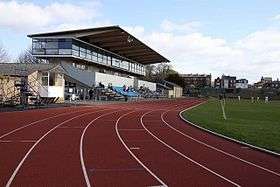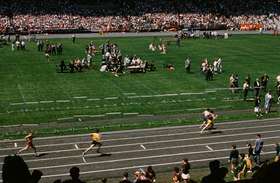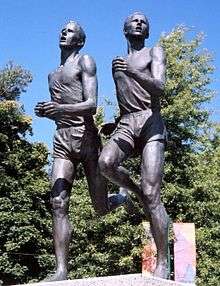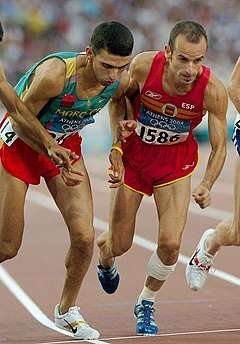Four-minute mile
A four-minute mile is the completion of a mile run (1,760 yards, or 1,609.344 meters) in four minutes or less. It was first achieved in 1954 by Roger Bannister, at age 25, in 3:59.4.[1] The "four-minute barrier" has since been broken by over 1,400 male athletes,[2] and is now the standard of all male professional middle distance runners in cultures that use Imperial units. In the 65 years since, the mile record has been lowered by almost 17 seconds, and currently stands at 3:43.13, by Hicham El Guerrouj of Morocco, at age 24, in 1999.[3][4] Running a mile in four minutes translates to a speed of 15 miles per hour (24.14 km/h, or 2:29.13 minutes per kilometer, or 14.91 seconds per 100 meters).[5] It also equals 22 feet per second (1,320 feet per minute).

Record holders



Breaking the four-minute barrier was first achieved on 6 May 1954 at Oxford University's Iffley Road Track, by British athlete Roger Bannister,[6] with the help of fellow-runners Chris Chataway and Chris Brasher as pacemakers.[7]
Two months later, during the 1954 British Empire and Commonwealth Games hosted in Vancouver, B.C., two competing runners, Australia's John Landy and Bannister, ran the distance of one mile in under four minutes. The race's end is memorialised in a photo, and later a statue, of the two, with Landy looking over his left shoulder, just as Bannister is passing him on the right. Landy thus lost the race. The statue was placed in front of the Pacific National Exhibition entrance plaza.[8]
New Zealand's John Walker, who with a 3:49.4 performance in August 1975 became the first man to run the mile under 3:50, ran 135 sub-four-minute miles during his career (during which he was the first person to run over 100 sub-four-minute miles), and American Steve Scott has run the most sub-four-minute miles, with 136. Algeria's Noureddine Morceli was the first under 3:45. Currently, the mile record is held by Morocco's Hicham El Guerrouj, who ran a time of 3:43.13 in Rome in 1999.
In 1964, America's Jim Ryun became the first high-school runner to break four minutes for the mile, running 3:59.0 as a junior and a then American record 3:55.3 as a senior in 1965.[9] Tim Danielson (1966) and Marty Liquori (1967) also came in under four minutes, but Ryun's high-school record stood until Alan Webb ran 3:53.43 in 2001.[10] Ten years later, in 2011, Lukas Verzbicas became the fifth high-schooler under four minutes.[11] In 2015, Matthew Maton and Grant Fisher became the sixth and seventh high-schoolers to break four minutes, both running 3:59.38 about a month apart.[12] Webb was the first high schooler to run sub-4 indoors, running 3:59.86 in early 2001. On 6 February 2016, Andrew Hunter significantly improved upon Webb's mark, running 3:58.25 on the same New York Armory track[13] and 3:57.81 two weeks later.[14] Hunter achieved the 4-minute mile mark outdoors later in the season at the Prefontaine Classic. At that same meet Michael Slagowski ran his second sub-4-minute of the season.[15] Reed Brown dipped under the barrier on 1 June 2017, running the 4th fastest high school mile time ever recorded in a race: 3:59.30.[16] In 2020, Leo Daschbach clocked 3:59.54 during the Quarantine Clasico, moving to ninth on the all time list. [17][18]
Another illustration of the progression of performance in the men's mile is that, in 1994, forty years after Bannister's breaking of the barrier, the Irish runner Eamonn Coghlan became the first man over the age of 40 to run a sub-four-minute mile.[19] Because Coghlan surpassed the mark indoors and before the IAAF validated indoor performances as being eligible for outdoor records, World Masters Athletics still had not recognised a sub-4-minute-mile performance as a record in the M40 division. Many elite athletes made the attempts to extend their careers beyond age 40 to challenge that mark. Over 18 years after Coghlan, that was finally achieved by UK's Anthony Whiteman, running 3:58.79 on 2 June 2012.[20]
No woman has yet run a four-minute mile. As of 2019, the women's world record is held by Sifan Hassan of the Netherlands, with a time of 4:12.33 clocked at the Diamond League meeting in Monaco, in 2019.[21]
Prior to Hassan, Svetlana Masterkova's 1996 women's world record (4:12.56) had stood for almost 23 years. Masterkova became the first female athlete to run a mile in less than 4 minutes and 15 seconds.
In 1997, Daniel Komen of Kenya ran two miles in less than eight minutes, doubling up on Bannister's accomplishment.[22] He did it again in February 1998, falling just 0.3 seconds behind his previous performance of 7:58.61. He is still the only individual to accomplish the feat.[23]
The youngest runner to ever run a four-minute mile is Norwegian runner Jakob Ingebrigtsen, who ran 3:58.07 at the Prefontaine Classic in May 2017, when he was 16 years and 250 days old.[24] However indoor world champion Yomif Kejelcha of Ethiopia, born August 1st of 1997, ran 4:57.74 in an indoor 2000 m race on February 28, 2014 at age 16 years and 212 days.[25][26] The run averages to a pace of 3:59.58 per mile for the 1.24-mile race.
Possible other claims
A number of people have claimed to have beaten the four-minute mile before Bannister.
James Parrott (1770)
Some (notably Olympic medallist Peter Radford)[27] contend the first successful four-minute mile was run by James Parrott on 9 May 1770.[28] He ran the 1-mile, west-to-east, length of Old Street to finish somewhere within the grounds/building of Shoreditch Church. Timing methods at this time were - after invention of the chronometer by John Harrison - accurate enough to measure the four minutes correctly, and sporting authorities of the time accepted the claim as genuine. Old Street has a c. 11 foot downward fall (but note intermittent gentle undulations)[29] Neal Bascomb notes in The Perfect Mile that "even nineteenth-century historians cast a skeptical eye on the account."[30]
Weller Run (1796)
On 10 October 1796, The Sporting Magazine reported that a young man called Weller, who was one of three brothers, "undertook for a wager of three guineas to run one mile on the Banbury Road, in four minutes, which he performed two seconds within the time."[31] This is equivalent to £312 in 2019 yet about 5 months' a typical rural labourer's pay then. By the late 1700s, a mile could be routinely measured to within a few inches;[32] watches, thanks to John Harrison, could measure 4 minutes to within 0.0009 sec (i.e. gain or lose 10 seconds a month),[33] and after about 1750 the mass production of highly accurate watches was well underway.[34]
Glenn Cunningham (1920s)
It is also reputed that Glenn Cunningham achieved a four-minute mile in a workout in the 1920s. In addition to being unsubstantiated, a workout run would not count as a record.[35]
In popular culture
In 1988, the ABC and the BBC co-produced The Four Minute Mile, a miniseries dramatization of the race to the four-minute mile, featuring Richard Huw as Bannister and Nique Needles as John Landy (who was simultaneously pursuing the milestone). It was written by David Williamson and directed by Jim Goddard.[36]
In 2004, Neal Bascomb wrote a book entitled The Perfect Mile about Roger Bannister, John Landy, and Wes Santee, portraying their individual attempts to break the four-minute mile and the context of the sport of mile racing. A second film version (entitled Four Minutes) was made in 2005, starring Jamie Maclachlan as Bannister.[37]
In June 2011 the watch used to time the original event was donated by Jeffrey Archer to a charity auction for Oxford University Athletics Club; it sold for £97,250.[38]
In July 2016 the BBC broadcast the documentary Bannister: Everest on the Track, The Roger Bannister Story with firsthand interviews from Bannister and various other figures on the first sub-4 minute mile.[39][40]
See also
- Mile run
- Mile run world record progression
- Dream Mile
- 10-second barrier
- The two-hour marathon, a similar barrier that was broken in 2019 by Eliud Kipchoge as part of the Ineos 1:59 Challenge
References
- "Sports: Bannister stuns world with 4-minute mile". Sptimes.com. 17 December 1999. Retrieved 4 March 2012.
- "World Sub-4 Mile Alphabetic Register".
- "Most Popular". CNN. 8 May 2000.
- YouTube video: Hicham El Guerrouj sets a world record in the mile in 1999
- "Finding the Next Roger Bannister". Cameron Poetzscher's Sports Blog. Retrieved 29 May 2017.
- "1954: Bannister breaks four-minute mile". BBC Online. Retrieved 5 May 2014.
- Beard, Mary (25 April 2014). "How running has changed since the four-minute mile". A Point of View. BBC. Retrieved 5 May 2014.
- “Sir Roger Bannister: the day I reclaimed the four-minute mile”. ‘’The Telegraph’’. Retrieved 4 March 2018
- "Ryun's mile record is history; high schooler Alan Webb hits 3:53.43". Active.com. 15 March 2007. Retrieved 4 March 2012.
- "High School Records – Boys". Track & Field News. Archived from the original on 15 August 2010.
- Bill Carey (11 June 2011). "Verzbicas breaks four-minute mile". Sports Illustrated. Retrieved 11 June 2011.
- http://www.kval.com/sports/Future-Duck-Matthew-Maton-enters-record-books-with-under-4-minute-mile-303179181.html
- Dutch, Taylor (6 February 2016). "Drew Hunter Smashes Alan Webb's High School Mile Record in 3:58". FloTrack. Retrieved 23 May 2016.
- "Drew Hunter Does It Again – Runs 3:57.81 for a New High School Indoor Mile Record". LetsRun.com. 20 February 2016. Retrieved 23 May 2016.
- "Kendra Harrison Breaks 100mH American Record, Full Prefontaine Recap". Retrieved 9 May 2017.
- "Reed Brown breaks 4:00". milesplit.com. 1 June 2017. Retrieved 2 June 2017.
- "Leo Daschbach Breaks 4:00 In Mile; Supreme 56.81 Last Lap Allows Him To Become 11th US Boy To Do So". LetsRun. LetsRun. Retrieved 24 May 2020.
- "2020 The Quarantine Clasico". RT Live Results. RT. Retrieved 24 May 2020.
- Dan Giesen (20 April 1996). "Scott Sets New Goals As He Turns 40". San Francisco Chronicle.
- "Music City Distance Carnival – Complete Results – Tennessee Runner". Tn.milesplit.com. Retrieved 13 August 2012.
- "Diamond League: Laura Muir third in 800m, Sifan Hassan breaks mile world record". BBC Sport.
- "World Records and Best Performances: Men's Track & Field". Athletics Weekly. Retrieved 11 June 2011.
- "Men's 2 miles". www.alltime-athletics.com. Retrieved 9 May 2017.
- "16-year-old Jakob Ingebrigtsen becomes youngest ever to break four minutes for mile". Retrieved 27 May 2018.
- Yomif Kejelcha at IAAF
- "2014 IAAF results for Yomif Kejelcha".
- Radford, Peter (2 May 2004). "The Time a Land Forgot". The Guardianun.
- "The first four-minute mile". East London History. 2004. Archived from the original on 13 October 2004. Retrieved 11 May 2007.
- Ordnance Survey: London (1915 - Numbered sheets) V.6, Revised: 1913, Published: 1916
- Bascomb, Neal (2004). The Perfect Mile: Three Athletes, One Goal, and Less Than Four Minutes to Achieve It (1st Mariner Books ed.). Boston: Houghton Mifflin Co. p. 60. ISBN 978-0-547-52506-8.
- Fletcher (9 May 2014). "The 18th Century 4 Minute Mile". BBC News Magazine.
- Radford, Peter (2 May 2004). "The Time a Land Forgot". The Guardian.
- "John Harrison and the invention of the chronometer".
- "History of Watches".
Widespread population gained access to pocket watches only in the second half of the 18th century when popular lever escapement enabled clockmakers to produce cheap and very precise watches"
- Kiell, Paul (2006). American Miler: The Life and Times of Glenn Cunningham. Breakaway Books. pp. 93–94. ISBN 1-891369-59-8.
- "The Four Minute Mile (TV Movie 1998) – iMDb". imdb.com. iMDb. Retrieved 5 May 2019.
- "Four Minutes (2005)". www.rottentomatoes.com. Rotten Tomatoes. Retrieved 5 May 2019.
- White, Belinda (28 June 2011). "Margaret Thatcher's handbag sells for £25,000". Fashion.telegraph.co.uk. Archived from the original on 16 November 2011. Retrieved 4 March 2012.
- "Bannister: Everest on the Track: a reminder of what clean running looks like: review". Retrieved 29 July 2016.
- Chavez, Chris (11 April 2016). "Q&A with Tom Ratcliffe, director of Bannister: Everest on the Track". Sports Illustrated. Retrieved 14 December 2016.
Further reading
- Bannister, Roger (1955). The First Four Minutes. Putnam.
- Bascomb, Neil (2004). The Perfect Mile. Willow. ISBN 978-0-00-717373-0.
- Bryant, John (2004). 3:59.4 The Quest To Break The Four Minute Mile. Hutchinson. ISBN 978-0-09-180033-8.
- Nelson, Cordner; Quercetani, Roberto (1985). The Milers. Tafnews Press. ISBN 0-911521-15-1.
- Phillips, Bob (2004). 3:59.4 The Quest for the Four-Minute Mile. Parrs Wood Press. ISBN 978-1-903158-49-4.
External links
- Roger Bannister and the Four-Minute Mile Original reports from The Times
- Forbes magazine declared four-minute mile as "greatest athletic achievement"
- The Four Minute Mile on IMDb
- Four Minutes on IMDb
- Official website for documentary – Franz Stampfl: The Man Behind the Miracle Mile – a film about the coach behind Bannister's successful mile record attempt